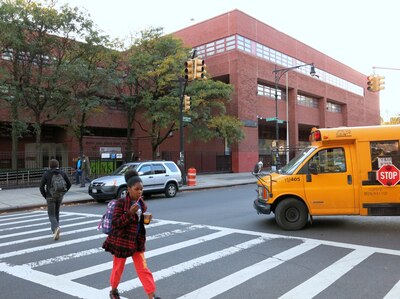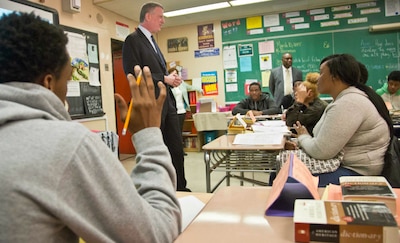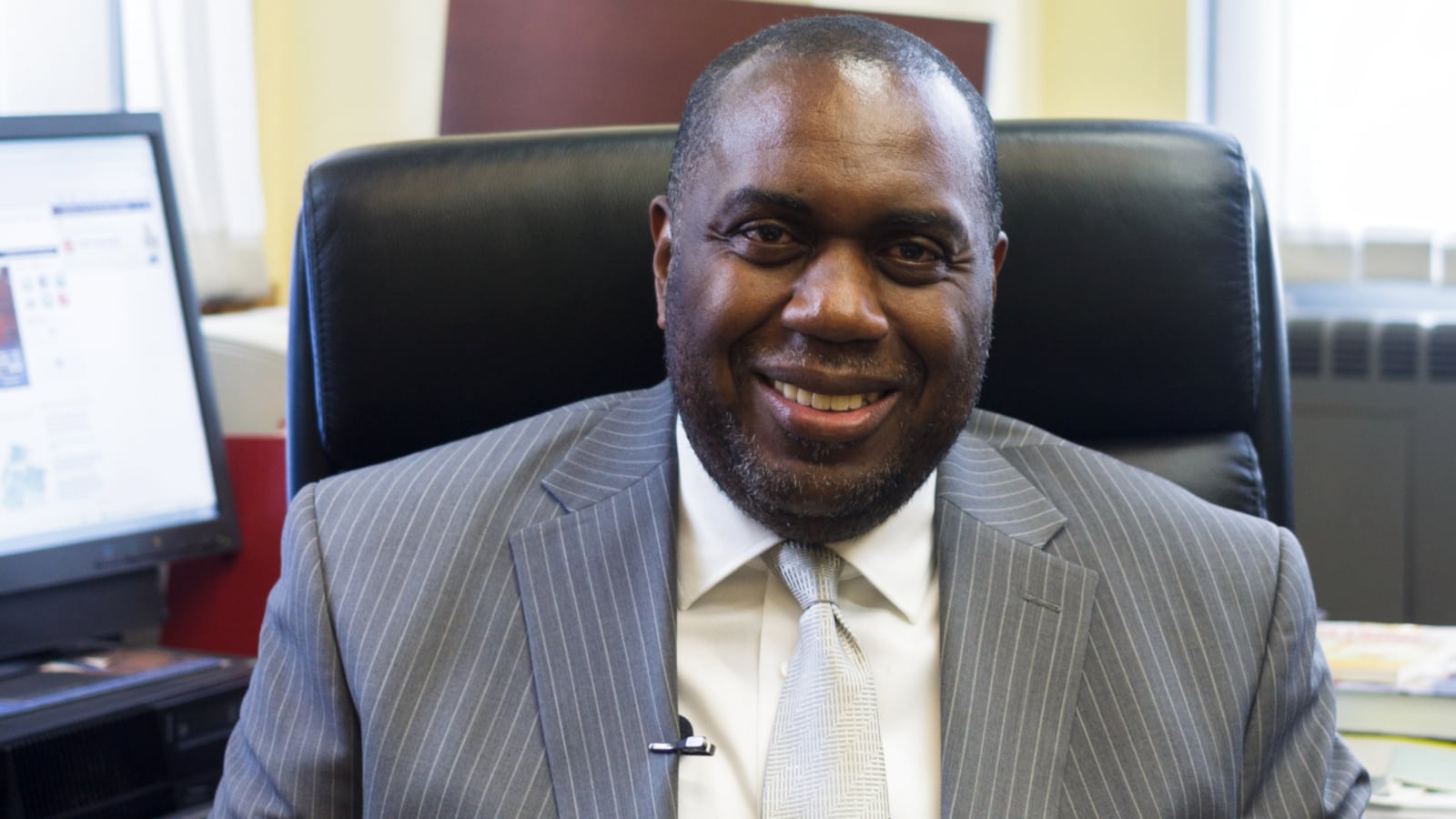Long-struggling Boys and Girls High School was in such dire straits by 2014 that the city took a highly unusual gamble: It paid a successful principal a big bonus to take on the floundering school without making him give up his old job.
A year and a half later, it’s become clear that the deal has cost the city — and students at both schools.
The principal, Michael Wiltshire, has rejected the city’s school turnaround program but continues to earn praise from top education officials even though many say the unusual arrangement has gone off the rails.
Wiltshire has openly questioned a core tenet of Mayor Bill de Blasio’s signature school-improvement program: that each struggling school must partner with a nonprofit, which is tasked with helping treat students’ social and emotional needs. After repeatedly clashing with Wiltshire, Boys and Girls’ partner organization informed him this week that it will no longer work with the school after this year.
In addition, Wiltshire’s controversial plan to move his former school, the high-performing Medgar Evers College Preparatory School, into Boys and Girls’ Bedford-Stuyvesant campus has caused a headache for the city. The proposal stoked suspicions at Boys and Girls that Wiltshire arrived at his new job with ulterior motives, even as Medgar Evers parents voiced concerns about the move. Still, the city went along with Wiltshire, turning his plan into an official co-location proposal — one whose future is now in doubt after a Medgar Evers leadership team officially rejected the move on Friday.
Finally, when critics questioned the idea of putting a single principal in charge of two schools when one of them is among the state’s lowest-performing, education department officials insisted that his role at Medgar Evers would be limited. But now, after Medgar Evers’ acting principal was removed from the school in March due to an investigation and has not been replaced, Wiltshire is devoting significant time and attention to his old school.
“It’s not working out for us at all,” said a Boys and Girls staffer who, like other employees and parents interviewed, requested anonymity to avoid retaliation. “We need a dedicated principal.”
But if some people at both schools are questioning the arrangement, others continue to support it — including Chancellor Carmen Fariña, who praised Wiltshire at a City Council hearing this week.
“Having a principal who’s a master principal working in that building has made a difference,” she said about Boys and Girls. Wiltshire “is trying to simultaneously run another school, but I think it’s actually worked well.”
“Community school” clash

As required under de Blasio’s “Renewal” turnaround program, Boys and Girls brought in a nonprofit partner whose charge is to help convert the low-performing school with a dwindling enrollment into a “community school” loaded with social services.
But Wiltshire has butted heads with its partner, the respected social-service agency Good Shepherd Services, almost from the moment he took over the school in Oct. 2014, sources there said.
The agency is contracted to provide counseling and a host of other support services to Boys and Girls’ students, three-quarters of whom live in poverty and 60 percent are considered “chronically absent.” But Wiltshire has only allowed Good Shepherd staffers to meet with students during lunch and has barred them from entering classrooms, sources said. (By contrast, other schools in the Renewal program allow nonprofit staffers to co-teach classes or to provide one-on-one help to students during lessons.)
And while the agency’s state grant requires them to provide a minimum of 15 hours of after-school programming each week, Wiltshire has only permitted them five, the sources added.
In addition, while the principals of some Renewal schools have embraced the nonprofit workers brought in to manage all the new social services as co-leaders, whom they meet with regularly, Wiltshire has not had a substantive meeting with his “community school director” for several months, the sources said. When the director and another Good Shepherd staffer asked the parent-association president last month to be added to a meeting agenda so they could explain what a community school is, Wiltshire intervened.
“Good Shepherd Services is a [community-based organization] whose sole purpose is to provide specific services for Boys and Girls High School,” he wrote in an email to the president and the staffers that Chalkbeat obtained. He went on to suggest that Boys and Girls is not a community school — at least not one managed by Good Shepherd.
“Which Community School are they going to speak about? Certainly not Boys and Girls HS,” he wrote. “I need some clarity on this matter before they are added to agenda, specifically on the school that they will be speaking about.”
Finally, after speaking with the school’s superintendent and the head of the community school initiative to discuss the situation, a Good Shepherd official emailed Wiltshire Tuesday to inform him that they would be parting ways after next month.
“It’s very important in a community school that the principal and the partner organization share the same vision for the school,” Michelle Yanche, Good Shepherd’s associate executive director for government and external relations, told Chalkbeat. “But in our case, Good Shepherd Services and Principal Wiltshire have different visions about what our shared work should look like.”
In an interview, Wiltshire disputed the notion that he had obstructed Good Shepherd’s work. He also said, “I don’t intervene in PTA decisions as to who speaks at their meetings.”
But he did not deny his aversion to letting students meet with counselors during the school day.
“At Boys and Girls, we have serious academic problems,” he said. “This is not about socialization and a feel-good thing; it’s about giving students the academic support they need.”
He said students can meet with guidance counselors for part of their hourlong lunch period, and they can participate in non-academic activities after school on Mondays and Fridays. He added that if students were allowed to visit counselors during the day, some would do so just to skip class.
“You have to be careful because some kids who don’t want to go to class will always have ‘social-emotional issues,’” he said, adding, “There’s no ‘social-emotional’ class. They need to pass their Regents.”
That attitude has deeply offended some Good Shepherd staffers, who believe that students who are suffering because of traumatic home lives need emotional support in order to excel in class. In fact, that is the philosophy underpinning de Blasio’s decision to convert every low-performing Renewal school — including Boys and Girls — into a community school.
Community schools “focus on all of a child’s needs – not just academics,” de Blasio said in 2014 when he unveiled the $400 million program. “They address a child’s mental, physical, social, and emotional well-being, in addition to their academic needs.”
Education department spokeswoman Devora Kaye said that Good Shepherd would continue to work with another school on Boys and Girls’ campus. She added that the department would help Wiltshire find a new partner organization, and “ensure both parties are contributing.”
A stalled move

Only a few months after Wiltshire took the reins of Boys and Girls, he floated a plan that startled several people there: He wanted to combine the historic but long-declining school with Medgar Evers, his former high-flying school just two miles away.
The merger would involve moving Medgar Evers’ 1,225 students from their cramped Crown Heights building that has no gym or auditorium into Boys and Girls’ massive campus, which the city says is filled to just a quarter of its capacity. In return, Boys and Girls students would be able to take honors classes at Medgar Evers, and the schools’ teachers could train and plan lessons together.
Some Boys and Girls’ staffers and alumni saw the proposal as a covert takeover — especially after Wiltshire suggested calling the combined school Medgar Evers College Preparatory School at Boys and Girls High School. The tensions grew after Medgar Evers’ leadership team requested a separate entrance at the shared building so that their students would not have to pass through Boys and Girls’ metal detectors.
People in the Bedford-Stuyvesant community did not want “students from Medgar Evers to come in feeling more privileged than the students at Boys and Girls,” said NeQuan McLean, president of the local community education council.
Months after Wiltshire floated the merger, the education department issued a formal proposal to move Medgar Evers into the other building (though the two schools would remain separate entities). After Medgar Evers parents and faculty opposed the city’s proposal to move the school’s middle grades a year ahead of its high school grades, the department revised the plan to move all the grades at once.
But that did not quell their concerns and, on Friday, the school’s parent-faculty leadership team formally rejected the move. In an email to department officials this week, the team gave several reasons: Boys and Girls’ campus houses a school for students who may be up to 21 years old, Medgar Evers students would have access to just one of three science labs, and they would lose their proximity to Medgar Evers College, where some students take early-college classes.
Suddenly, a move for which Wiltshire has been lobbying for over a year is in peril — even after the city turned it into an official proposal and modified it to make it more palatable for Medgar Evers. Kaye, the department spokeswoman, said the agency is listening to the leadership team’s concerns and assessing the next steps.
But Wiltshire seems to have already bowed to the team’s wishes, and is changing his request.
“Medgar deserves really to have a campus of its own,” he told Chalkbeat. “Why can’t the city invest a few millions dollars into a highly successful school?”
Divided attention
Department officials have insisted from the start that Wiltshire would “support” Medgar Evers when necessary, but would only oversee the day-to-day operations of Boys and Girls.
“He will not be running both schools,” Kaye said in Oct. 2014.
However, several Medgar Evers parents said that Angella Smith, the former assistant principal who until recently was serving as acting principal, repeatedly responded to questions by saying she had to ask Wiltshire.
“She doesn’t do any decisions without checking with him,” one parent said before Smith was reassigned in March while the city conducts an investigation involving her. Another said this week: “It definitely felt like it wasn’t clear who was in charge.”
Since taking over Boys and Girls, Wiltshire has continued to visit Medgar Evers multiple times a week, according to people at both schools. After the city removed Smith without appointing a replacement, his presence has only intensified. A Medgar Evers teacher said he visits the school almost daily — sometimes staying the entire day; other times stopping by in the morning, then returning in the afternoon.
“Dr. Wiltshire is here practically every day,” she said. “I don’t know how he’s juggling it.”
In response to that description of Wiltshire’s near-daily presence at Medgar Evers, Kaye said in an email Thursday: “As a master principal, he is the principal at Boys and Girls and continues to support Medgar. This continues to be his role.”
Some people at both schools said they are uncomfortable with this dual role, but others said that Wiltshire has been able to pull it off without letting either school suffer. Lorna Fairweather, a Medgar Evers parent and leadership team member, said students at that school are continuing to thrive even as a handful of Boys and Girls students have been able to take advanced classes there.
“He’s doing a fantastic job with both schools,” she said.
Wiltshire shares that assessment. He noted Wednesday that Boys and Girls’ graduation rate has already increased under his watch from 42 percent in 2014 to 50 percent last year, while Medgar Evers’ has bumped up during that time from 92 to 96 percent.
“I think what I’m doing,” he said, “in terms of splitting my time in both the schools, is wonderful.”

